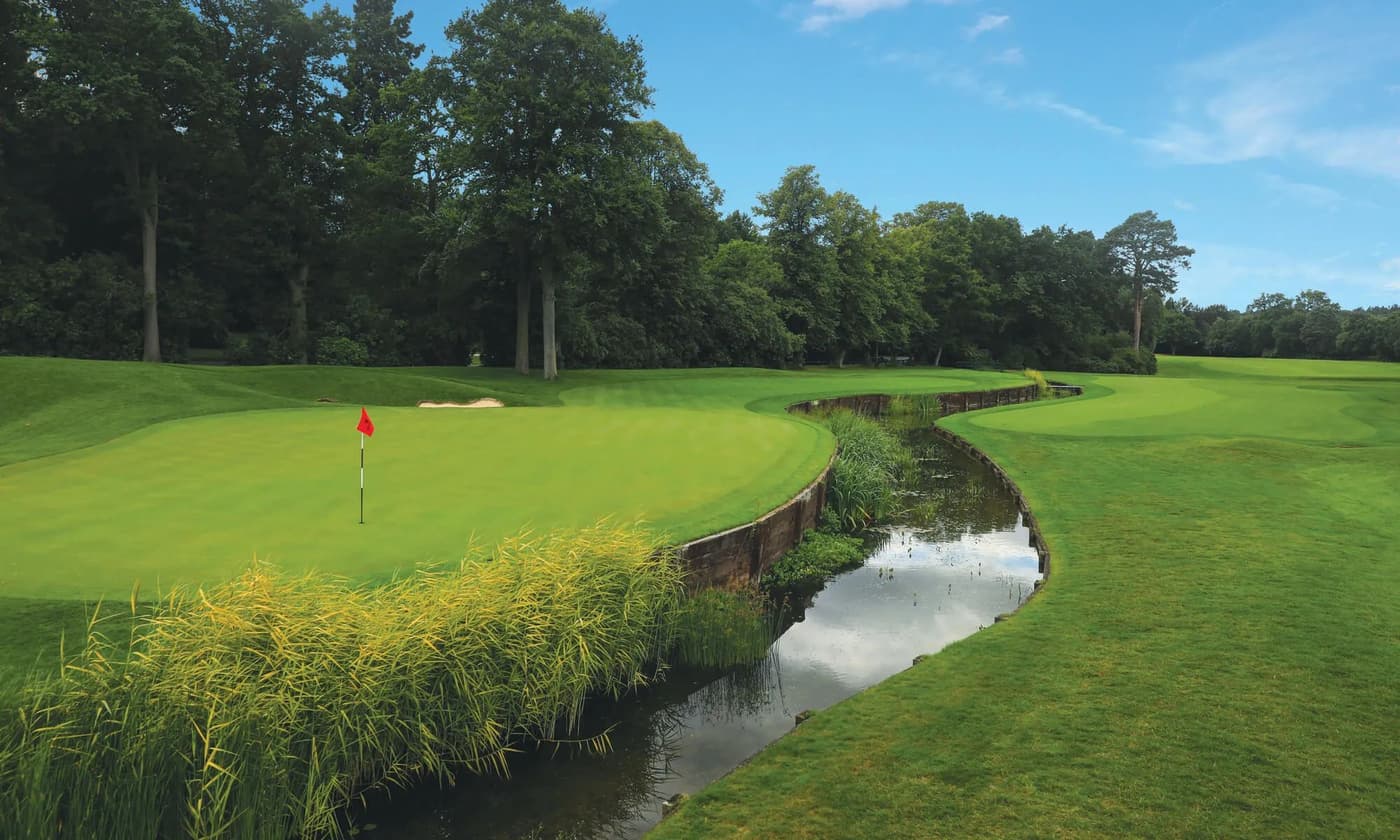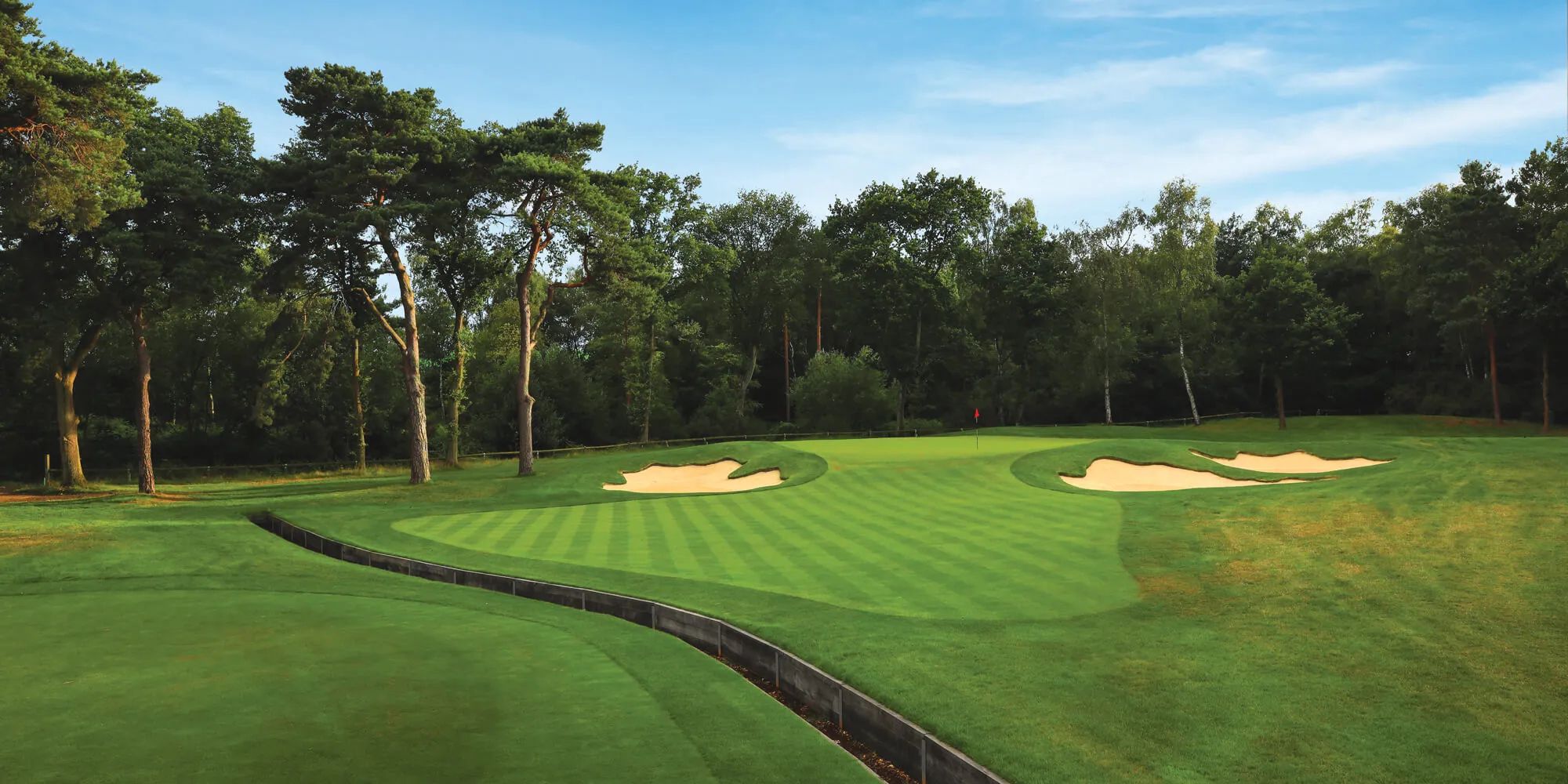
Wentworth (West)
Surrey, England
- AddressWentworth Dr, Surrey GU25 4LS, UK
- Championships hosted
Wentworth Golf Club played host to the 1953 Ryder Cup matches between the USA and Great Britain. Team Captains were Lloyd Mangrum (US) and Henry Cotton (GB). This was one of the most fiercely contested competitions in Ryder Cup history and the Americans had to wait until the closing stages of the singles matches before gaining a single point victory. Peter Alliss took a six at the final hole to lose 1-up to Jim Turnesa and Bernard Hunt missed a putt on the 18th green to halve with Dave Douglas. U.S. Captain Lloyd Mangrum said he would “never, never captain an American team again because of the 9,000 deaths I suffered in the last hour”. USA 6 ½ - GB 5 ½. The Ryder Cup was played at Pinehurst in 1951 and at Thunderbird in 1955.
The West course at the Wentworth Club is the most famous of the Surrey heath and heather courses. The club is also the most televised in Britain, once hosting three professional tournaments every year (World Matchplay, PGA and the Seniors Masters), but now only the PGA Championship is staged annually at Wentworth. The West course was also the venue for the fiercely contested 1953 Ryder Cup, resulting in a single point American victory 6½ 5½.


It must have been an absolute delight for Harry Colt when he was asked to design the West course, which opened for play in 1926. After all, he was already familiar with this landscape, having designed the East Course (founded two years earlier).
The West is a relative youngster in the scheme of things. Many of Surrey’s famous sand-belt courses were established around the turn of the 19th century. Wentworth was also one of the first golf course developments to feature fairway-side houses, quite a number of which are owned by well-known celebrities. It’s a sort of up-market 1920s golf and country club complex.
Bernard Darwin refers to the West Course as the Tiger Course in his book, Golf Between Two Wars. He writes: “The course is intended to test that rampacious animal to the full. It is a little hard to assign the Wentworth country as a whole to any precise class. There is heather and there are trees and yet it is not quite of the same nature as its near neighbour, Sunningdale. It is set in park-like surroundings, and yet it is certainly not what is usually called a park course. It is a cross between the two, although the Tiger Course has about it least of the park and most of the heathery character”.
At the start of the Second World War, the Army requisitioned the clubhouse and labyrinths of underground bunkers were built. Deep below the famous clubhouse lies a secret wartime HQ. It was the Second World War that gave rise to the other name for the West Course – “Burma Road”. The course was allowed to grow wild because it was feared that enemy aircraft might land on the fairways. Towards the end of the war, German prisoners were brought in from a nearby internment camp to clear the course. One of the officers overseeing the clearance operation reputedly said: “Let this be their Burma Road”.
There are many memorable holes on the West course. The 2nd is a charming, exacting short 155-yard par three; a huge sentry oak stands between two bunkers guarding the right-hand side of the plateau green, the tee is level with the green, but the tee shot must carry across a valley to find the putting surface, don’t be short. Next, we come to the 3rd, a brutal, uprising 448-yard par four; avoid the bunkers on the right-hand side of the fairway, positioned 250 yards from the tee. Otherwise any chance of reaching the green in two has gone. A crisp accurate long iron or a fairway wood will reach the huge, 37-yard deep, three-tiered green that is protected by a bunker to the left and a bunker to the right; three-putting is commonplace. The 13th is yet another of the West’s long par fours (par five for the ladies). The hole sweeps around to the left, the green is invisible from the tee; the obvious line for the tee shot is down the right-hand side of the fairway, but here lies a cleverly located bunker. A good drive down the right of the fairway will leave a tough approach to a subtly contoured green that is protected by two bunkers to the left and two to the right. A par here will definitely feel as good as a birdie.
The last hole we'll mention is the famous bunkerless 17th. It’s a huge 566-yard par five that seemingly sweeps infinitely to the left – from the narrow tee there are tall trees on both sides, creating a tunnelling effect. A footpath dissects the hole some 200 yards away. The ball must be struck down the right-hand side of the fairway – anything left will be blocked out by trees or, worse still, out-of-bounds. Only the longest hitters should take the strategic line down the left side of the fairway, a solid 300-yard swish will make it to the corner of the dogleg. The approach shot is played blindly over a rise, aim for the large oak in the distance, but be aware that everything slopes onto the green and then everything seemingly slithers off again.
| "Feel the heritage, feel the glamour, feel special in strangely familiar surroundings." |
When you step onto the first tee of the West course, you will feel an overwhelming sense of familiarity. It is definitely a place most people would be more than happy to call home and play the monthly medal here for the rest of their lives. The holes weave their way through sprinklings of heather and across gently undulating terrain with mature trees lining each and every fairway. This is a truly classy golf course and it's a tough one too, especially after Ernie Els gave the West a new set of teeth. It now measures more than 7,300 yards from the tips and with many new bunkers and some new tiger tees, the Burma Road is now a serious 21st century challenge.
The West course closed to visitors for twelve months from 1st June 2009 for an extensive £6.5m renovation programme. Ernie Els was in charge of the changes which included 18 new USGA specification greens, new bunkers and a new canal-like stream, which protects the green on the famous closing hole. The new-look Burma Road received mainly positive comments from the pros at the 2010 BMW PGA Championship, but Paul Casey argued that the changes had stripped the West course of its character. Click here for the 2010 press release – “All Change On The West”.
The West came in for further criticism during the 2011 BMW PGA Championship. Ian Poulter joined forces with Paul Casey stating, “I don't like this golf course. Period. End of story.” Poulter went on to say, “Some of the fun of the last few holes has been taken away.” Wentworth’s former owner, Richard Caring, stated after the 2010 event that he had not quite got it right first time. Caring admitted, “the 18th was a dream I had, I wanted to give the spectators a bit of excitement, a bit of theatre. We might have gone slightly too far because it’s proven to be quite difficult.”
Ernie Els was against the changes to the 18th, and the green was lowered for the 2011 event with the depth of the putting surface extended to invite second shots. However, the 18th still proved to be too difficult for most pros and the vast majority opted to play the home hole as a three-shotter.
The 2011 PGA Championship took its toll on most of the field but the play-off was all set to be a thrilling affair featuring World No.1 Lee Westwood and World No.2 Luke Donald pitching their wits in a sudden death head-to-head on the 18th. Neither player opted to go for the green in two and both players had similar pitches into the green. Donald judged his pitch and spin to perfection but Westwood’s pitch spun off the green into the new canal. The play-off turned into a flop rather than a thriller. Donald not only claimed the PGA Championship title but also knocked Westwood off the World Number One spot in the process.
The West course closed immediately after the 2016 PGA Championship for yet another major redevelopment. Ernie Els Design, in conjunction with European Golf Design, were commissioned to handle the renovations, which includes the redesign of five greens, the installation of sub-air systems on every green (the first of its kind in England) and a reduction in the number of bunkers. The project completed prior to the 2017 PGA Championship.
Despite numerous multi-million pound renovations over the last decade, the West course has continually fallen from favour in the golf course rankings. Will the latest iteration arrest the decline? The rise and fall of the troubled Burma Road
Course Reviews
Leave a Review
This course has not been reviewed.
If you have played this course, consider .
Thanks for the review
Your review has been successfully submitted and will be reviewed for approval.
Course Reviewed
You’ve already submitted a review for this course.
Course Architect
View All
Harry Colt studied law at Clare College, Cambridge. Twelve months after his 1887 enrolment, he joined the committee of the Cambridge University Golf Club and in 1889 became the club's first captain.


